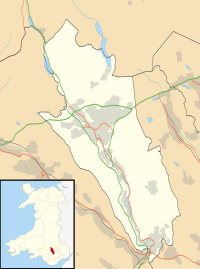Cyfarthfa Castle
| Castell Cyfarthfa | |

Front view of Cyfarthfa Castle
|
|
|
Location within Merthyr Tydfil
|
|
| Established | 1824 |
|---|---|
| Location | Park, Merthyr Tydfil, Wales |
| Coordinates | 51°45′24″N 3°23′25″W / 51.75666°N 3.39014°W |
| Type | Historic house museum, art museum |
| Architect | Robert Lugar |
| Owner | Merthyr Tydfil Leisure Trust |
| Website | Cyfarthfa Castle |
Cyfarthfa Castle (Welsh: Castell Cyfarthfa; [kəˈvarθva]) is a castellated mansion that was the home of the Crawshay family, ironmasters of Cyfarthfa Ironworks in Park, Merthyr Tydfil, Wales. The house commanded a view of the valley and the works, which ‘at night, offer a truly magnificent scene, resembling the fabled Pandemonium, but on which the eye may gaze with pleasure’. Cyfarthfa loosely translates from the Welsh for place of barking. The reason is hunting dogs were regularly heard in this area of the town, hunting polecats and weasels among others.
Despite appearing to be a fortified building, it is a house built in the style of a large mansion with a large kitchen, bake house and dairy, billiard room, library, and a range of reception rooms. In addition, there is a brew house, icehouse and extensive storage cellars that used to contain over 15,000 individual bottles of wines and spirits such as Sherry, Champagne, Whiskey, Brandy, Madeira Wine, and over 7,500 bottles of port. Adjoining the building were also stable blocks and coach houses. The castle stands in 158-acre (64 ha) of parkland, now called Cyfarthfa Park and maintained by Merthyr Tydfil County Borough Council.
The castle was designed in 1824 by the architect Robert Lugar for William Crawshay II, and built at a cost of approximately £30,000 using locally quarried stone. The Crawshays lived in the house until 1889. The noise and pollution made Cyfarthfa Castle unattractive to William; he preferred a site that overlooked the works rather than one that sat within it.
The castle was sold in 1908 to the local council, who were initially unsure as to what purpose it should be put. Eventually, they decided to use part of the ground floor for a museum, which still operates. The museum includes paintings, including two by James Inskipp.
The rest of the building became a secondary school, and it was opened in 1913, operating as separate boys` and girls` schools. In 1945, they amalgamated, and in accordance with government policy the school was redesignated as a Grammar school under the name of Cyfarthfa Castle Grammar School. It became a comprehensive school in 1970, under the name Cyfarthfa High School.
...
Wikipedia

